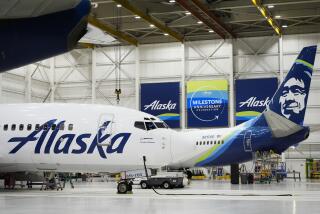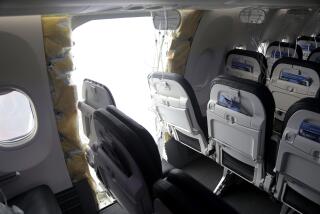Wear on Jet’s Stabilizer Device Found 3 Years Ago
- Share via
A 1997 inspection of the Alaska Airlines jet that crashed off Anacapa Island two weeks ago uncovered a crucial jackscrew mechanism in the tail section so worn that maintenance crews briefly considered replacing it, transportation safety officials said Sunday.
But maintenance crews reconsidered replacing the part in the rear stabilizer after reinspecting the mechanism and deciding that the wear was within specified tolerances, the National Transportation Safety Board said.
In fact, the NTSB said maintenance records show that Alaska crews rechecked the stabilizer’s jackscrew and gimbal nut on the ill-fated plane five more times--with the same results--before deciding not to replace the parts.
NTSB officials, in a late-night statement, would not comment on the significance of the maintenance records, other than to say: “no determination has been made as to whether this information has any bearing on the accident.”
But the stabilizer system is the primary focus of the investigation into the crash of Alaska Flight 261, which killed 88 passengers and crew Jan. 31.
The jackscrew moves up and down through the nut, raising and lowering the leading edge of the stabilizer--the wing-like part of the jetliner that controls much of the up-and-down pitch of the plane’s nose.
The gimbal nut from Flight 261, which was recovered from the ocean floor last week, several days after the plane’s jackscrew was recovered, was found to have stripped threads, the NTSB said.
In radio conversations with maintenance personnel and air traffic controllers, the pilots of the ill-fated flight said they were having trouble controlling their plane because of problems with the stabilizer.
The stabilizer eventually jammed in the nose-down position, and 12 minutes later the MD-83 spiraled down into the ocean.
The 1997 inspection of the jackscrew and gimbal nut assembly took place at Alaska Airline’s Oakland facilities, which have been at the center of two federal investigations into accusations that mechanics falsified inspection records and allowed two airplanes to fly in “unairworthy” condition.
The probes, by a criminal grand jury in San Francisco and the Federal Aviation Administration, involve work done on at least two MD-80 series aircraft, but not on the Alaska jet, which crashed en route to San Francisco and Seattle from Puerto Vallarta, Mexico.
The maintenance records, uncovered by the NTSB’s Maintenance Records Group--one of several NTSB panels investigating the crash--show that the Alaska jet underwent a major maintenance overhaul, known as a “C-check,” on Sept. 29, 1997. The inspection was the last involving the wear tolerance of the jackscrew and gimbal nut. C-checks are typically done every 15 to 36 months, depending on the amount of service provided the plane.
NTSB Chairman Jim Hall said maintenance records show that the initial check of the jackscrew and gimbal nut found “the maximum allowable end play limit,” or the maximum wear allowed.
“The initial plan of action was to replace the nut,” he said.
But Hall said the decision was reevaluated on Sept. 30, during a second inspection that found the wear tolerance “fell within specified tolerances.”
Hall declined to comment on the latest findings, saying “there has been no attempt to analyze the significance of this.”
The Federal Aviation Administration has ordered the inspection of more than 1,100 airliners after metal shavings were found in the horizontal stabilizer mechanisms of two jetliners like the jet that crashed.
The FAA ordered that the inspections must be completed by tonight.
Already, the inspections have turned up problems with the horizontal stabilizers in 21 planes belonging to several airlines.
More to Read
Sign up for Essential California
The most important California stories and recommendations in your inbox every morning.
You may occasionally receive promotional content from the Los Angeles Times.











